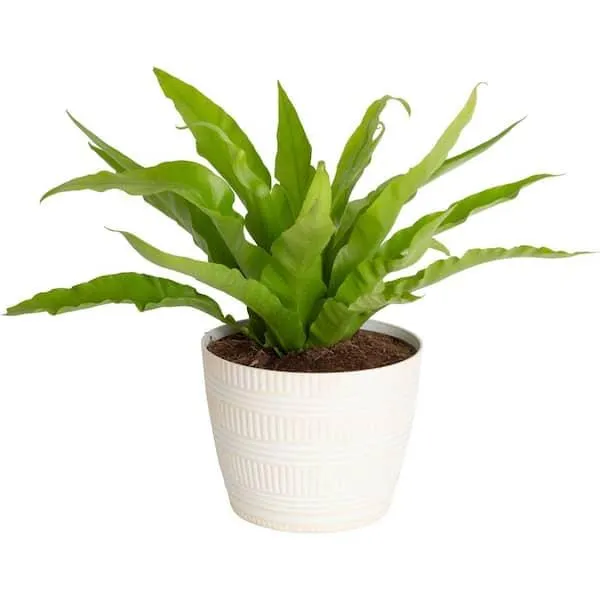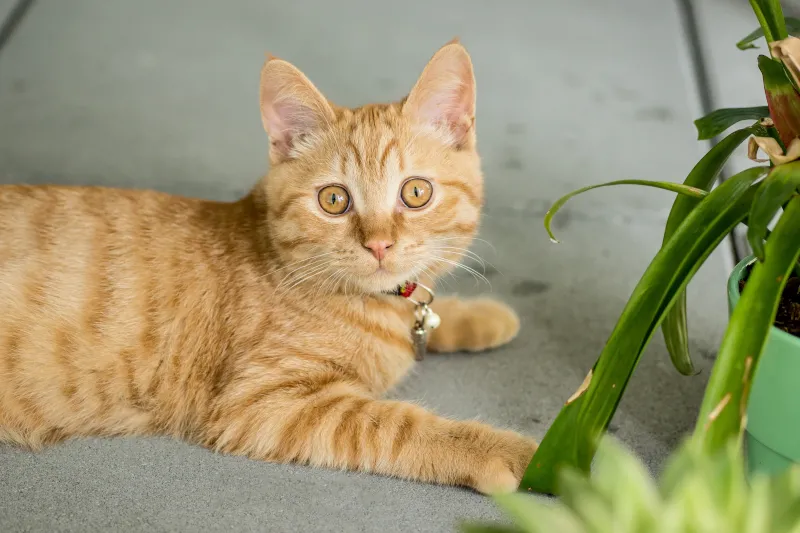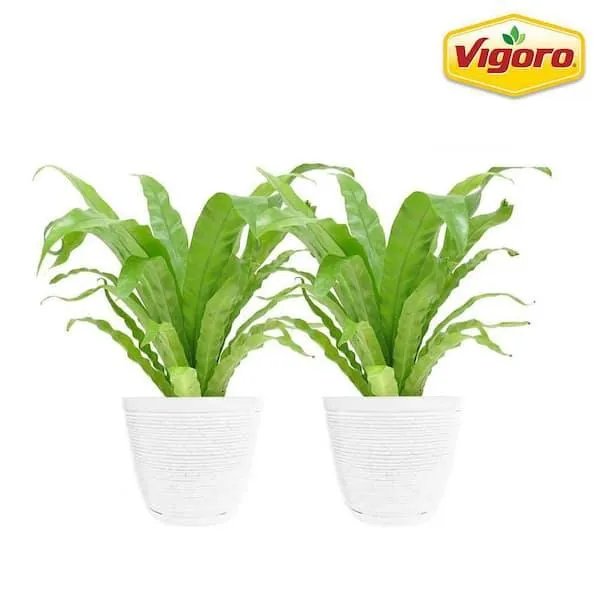Are Bird’s Nest Ferns Safe for Cats?
If you’re thinking about adding some greenery to your home with a beautiful bird’s nest fern, you may be wondering whether your furry feline friends will be safe around this plant. As the proud parent of two cats myself, I understand the desire to cat-proof your plants. In this article, I’ll explore the safety of Asplenium nidus, also known as bird’s nest ferns, for cats and provide answers to all of your furry plant pest concerns.
Toxicity Level
The good news is that bird’s nest ferns are considered non-toxic to cats. According to the ASPCA’s Poison Control Center, this fern poses no health risk to cats who may chew or eat parts of the plant. While not all plant components have been fully researched for toxicity, there is no evidence that Asplenium nidus contains any compounds that would cause dangerous physiological effects in cats.
In my experience caring for numerous houseplants, some so-called “non-toxic” plants can still cause mild stomach upset if ingested. However, from what toxicology experts know so far about bird’s nest ferns, cats should be able to sample this plant without any ill effects.
Are All Plant Parts Safe?
While the plant itself presents no toxicity risk, you’ll still want to cat-proof a bird’s nest fern to deter your furry friends from nibbling or playing with it. In particular, I’d keep the soft, feathery fronds out of reach, as these parts are most likely to appeal to a cat’s natural hunting instincts. The coarse, vinelike rhizomes that these ferns grow from are less enticing to cats and present no special risk. So overall, all visible above-ground parts of the cultivated bird’s nest fern are considered non-poisonous to cats.

Attractiveness to Cats
When considering any new houseplant, I evaluate how enticing the foliage may be to cats as scratching or chewing posts. In this regard, bird’s nest ferns receive relatively low marks on the cat-appeal scale. While the feathery fronds may attract the occasional swipe or nibble due to their textures, these ferns lack the strong fragrances, colors, or shapes that really grab most cats’ attention.
From my own experience living with feline housemates, bird’s nest ferns seem to register moderately on cats’ plant-interest radar. However, our cats have never caused any damage beyond the occasional batting at fronds. So for most indoor cats, a bird’s nest fern may actually prove an appealing visual plant without significant risk of chewing or upheaval. But it’s always wise to take precautions with any greenery.
Catproofing Tips
To keep your feline friends safe while allowing you to enjoy this beautiful and nontoxic fern, here are some catproofing tips I’ve found effective:
- Place the pot up high, such as on a shelf or hanging planter out of jump/swipe range.
- Provide generous alternate scratching posts and toys to redirect natural scratching behavior.
- Use a top dressing of gravel or spikes around the base of the pot to deter digging or nibbling.
- Employ a plastic saucer under the drainage holes to collect any spilled soil and keep it inaccessible.
- Monitor kitty interactions with the plant at first to gauge how much supervision may still be needed.
With a little planning, bird’s nest ferns can absolutely coexist peacefully alongside cats in the home. By giving kitty their own enrichment toys and keeping plants safely elevated, everyone can stay out of trouble.

Kid and Pet Safety
Since kids and other non-feline pets may also be found underfoot in the home, it’s worth touching briefly on the safety of bird’s nest ferns for them as well. Thankfully, as discussed, this species presents negligible risks across the board. The fern’s physical structure also makes it challenging for young children’s grabbing hands to cause damage. Any responsible plant parenthood precautions you take for cats will naturally extend protection to all family members.
Health Benefits for Cats?
Amazingly, there is even some limited evidence that bird’s nest ferns may offer positive impacts for feline friends. Some people keep their cats away from all plants, but many pets seem relaxed browsing amongst nontoxic greenery. Anecdotal reports suggest the feathery fronds may appeal to cats’ natural desires to knead, scratch, and playfully paw at textured surfaces. This minimal physical and mental stimulation could promote health in indoor cats.
Additionally, many plant parents claim their ferns help humidify and purify the air. While today’s scientific understanding of air quality impacts on cats remains basic, reducing allergens and improving oxygen levels can’t hurt! So in moderation, bird’s nest ferns just may do more good than harm for curious kitties. As with all cat behavior, individual curiosity and tolerance levels vary.
In conclusion, the majestic bird’s nest fern poses negligible health risks to cats when used as an indoor houseplant. By taking basic precautions to keep this nontoxic fern out of chewing range and providing enriched scratching posts, cat guardians can feel comfortable including Asplenium nidus’ lovely foliage in their home décor. With their resilience and elegant structure, bird’s nest ferns prove an attractive, low-maintenance choice for feline-friendly plant parenthood. By understanding each member’s needs, people and pets can peacefully co-exist amongst the greenery. I hope exploring this topic has helped ease your mind about safely sharing your living space with both your flora and fauna friends. Please let me know if any other questions arise!

Birds Nest Fern Safety for Cats
| Common Name | Scientific Name | Toxicity Level |
|---|---|---|
| Birds Nest Fern | Asplenium nidus | Non-Toxic |
| The birds nest fern is safe for cats to be around. While cats may be curious about chewing on the leaves, the fern is not poisonous if ingested. | ||
| Keep the fern out of reach of chewing or climbing cats to prevent accidental ingestion. | ||
| The fern is not toxic to cats but may cause mild gastrointestinal upset if large amounts are eaten. |
FAQ
-
Is a birds nest fern poisonous to cats?
Basically, the birds nest fern itself isn’t toxic to cats. However, if a curious feline decides to nibble on it, they may end up with an upset tummy. The fern’s leaves are kinda spiny, so chewing could also be uncomfortable.
-
Will a cats be interested in a birds nest fern as a toy?
Some cats might see the fern as a fun plaything to bat around or even lay in the nest part! Then again, others won’t care for its prickly texture. Perhaps it depends on an individual cat’s personality. You’ll have to see if yours takes to it or not.
-
Can a cats disturb or damage a birds nest fern?
While a birds nest fern is pretty tough, an especially rambunctious kitty might do some harm if allowed to wrestle with it often. The fronds could break off or the nest get uprooted. At the same time, a calm cat just investigating it won’t necessarily cause issues. It’s more about how energetic your cat tends to get.
-
Are their any risks placing a birds nest fern where a cat can access it?
As long as the fern isn’t within reach of places a cat sleeps or lays, there aren’t major risks to having one as a houseplant. However, on the off chance kitty decides to nibble on it, be ready to scoop them up if they act oddly. Generally, as long as it’s not their primary food source, a birds nest fern shouldn’t pose problems. But watch for any signs of tummy trouble just in case.

-
How do I cat-proof a birds nest fern?
The best way is to put the pot up high, like on a tall shelf or hanging planter out of pawing range. You can also place it on a tall table or windowsill. Another option is to put spikes or double-sided sticky tape around the top of the soil to deter digging. Strong, narrow bars could go around the whole pot if kitty is a determined climber!
-
Can a finicky eater be given a clipping from a birds nest fern as a treat?
I wouldn’t recommend using clippings from your houseplants as cat treats. Even if the fern itself isn’t very poisonous, there’s no need to take a chance on an occasional nibble causing tummy troubles. It’s best to stick to actual pet-safe snacks. Or maybe try some of the semi-edible indoor plants listed as non-toxic if you need a green alternative.
